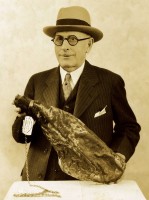Hops
|
Amount
|
Variety
|
Cost
|
Type
|
AA
|
Use
|
Time
|
IBU
|
Bill %
|
|
0.50 oz |
Magnum0.5 oz Magnum Hops |
|
Pellet |
12.5 |
Boil
|
60 min |
23.82 |
20% |
|
0.50 oz |
East Kent Goldings0.5 oz East Kent Goldings Hops |
|
Pellet |
4.3 |
Boil
|
15 min |
4.07 |
20% |
|
0.50 oz |
East Kent Goldings0.5 oz East Kent Goldings Hops |
|
Pellet |
4.3 |
Boil
|
5 min |
1.63 |
20% |
|
1 oz |
Challenger1 oz Challenger Hops |
|
Pellet |
8.5 |
Boil
|
1 min |
1.4 |
40% |
|
2.50 oz
/ $ 0.00
|
Mash Guidelines
|
Amount
|
Description
|
Type
|
Start Temp
|
Target Temp
|
Time
|
|
9.55 qt |
|
Infusion |
-- |
151 °F |
60 min |
|
5 qt |
mash out |
Temperature |
-- |
168 °F |
15 min |
Starting Mash Thickness:
1 qt/lb
|
Target Water Profile
Surrey 2013 British columbia
Notes
- yeast starter of 1L to wake up yeast
- hop aroma and target 28 - 30 IBU no more no less
- use various yeast strains, try thing that fermejnt dry frist, but don't be afraid to true less attenuative yeasts. This is supposed to act like a yeast experimental brew.
- if FG due to yeast higher than 1.014 drop some crystal malts in favor of ESB malt
- Mash lower for less attenuative yeasts like WLP002.
- Should I use a 1.75 Qt/lb or stick to 1.25? - what is typical of british beers???
-consider trying an open bucket fermentation, like on BTV episode 4 (consider fermenting slightly cooler if open) - for an open ferment, use wy1275 or wy1335 and use in swamp cooler style for temp control and cheese cloth*
-CONSIDER mashing for 90 mins instead of 60 to increase attenuation (still at 153/54)
- Mashing thin appears to induce a stronger malt profile?
-Ferment for 1 week to 2 weeks, then bottle, no longer than 2 weeks to prevent clean up, consider performing a D-rest, then reducing to cellar temps of 55F for conditioning phase after primary is over.
- Perhaps use Wy1968 as a baseline of open vs closed, then explore other strains?
- Does using sugar help the ester profile by "artificially" darkening the wort? Ie, using higher kilned malts may slightly inhibit ester production??? answers = Dunno? experiment with dark grains vs. dark sugars.
- Pitch proper amount of yeast, so moderate starter, and aerate the beer well to encourage healthy fermentation.
- Maintain final temp (whatever i choose like 63F) until FG is reached, and stir up yeast if attenuation is under. Once FG reached crash cool to 45F then rack to secondary and condition for another week at 55F? or lower?
- "Just a word of warning: If you really are planning on bottling this batch, I would make sure your final gravity is low enough to ensure the yeast don't reactivate once in the bottle. This yeast is notorious for going dormant in the fermenter only to 'wake up' after bottling, eating both the priming sugar and residual sugars in the beer; producing an over-carbonated, cidery taste. I've seen this happen soo many times, both in my own beers and while judging. For that reason, I rarely bottle carbonate beer fermented with this yeast. If I absolutely have to do it, I will crash cool the beer to near freezing as to flocc as much of the yeast out and then bottle using some US-05/champagne yeast. It doesn't always happen, but just be aware that it might."
- "It's all about fermentation control. Start with healthy yeast, aerate well, and don't let your fermentation temps fluctuate. Pitch below fermentation temperature, let rise to 68F for most of the fermentation, give it a good d-rest at 70F for a few days, then crash cool before kegging/bottling. All this should not take more than 2 weeks; and you'll still have a clean, flavorful beer."
- consider priming with fresh wort, or DME to avoid cidery flavors from 1968/002 or any of the other brittish yeasts*
- Pitch low (63F) then free rise to 68F till half ferm, then drop to 63F till FG then crash cool and rack to secondary, then raise to cellar??? 55f?? or bottle? or condition at 43F?
- once 1/5 to 1/4 to FG crash cool to 43F for 2 days followed by raising to 50F to cellar for min 2 weeks followed by chilling beer to -1 and hold for 1 week (to chill proof for bottling - but is filtered and flash pasteurized) so maybe got to FG to crash cool.
- also to note, the fullers beer is parti gyled, so there is no sparge which leads to fuller malt expression.
- fullers parti gyle method is to run the liquid off until they've reach their target volume, then divert to a second kettle for the other wort??
-oxidative flavor is present, but subdued. How to achieve it???
-------Yeasts of interest--------------
-Wyeast 1318 - London Ale 3 (boddingtons)
-WLP002 - English Ale (fullers)
-Wyeast 1275 - Thames Valley Ale (Brakspear/Wychwood?)
-Wyeast 1335 - British Ale 2 (adnams?)
-Wyeast 1469 - West Yorkshire Ale (Timothy Taylor) (use larger starter?)
-Wyeast 1187/WLP005 Ringwood Ale (Pripps - complex fermentation - read up)
-WLP037 Yorkshire Square (Samuel Smith's - seasonal)
WLP026 Premium Bitter (Marston's - known for paler beers - also needs long bottle conditioning time)
-WLP004/Wyeast 1084 Irish Ale (Guinness - not super interested, use last)

Last Updated and Sharing

- Public: Yup, Shared
- Last Updated: 2016-07-18 06:53 UTC
For quick copying and pasting to a text based forum or email.
Click the Download as HTML file button below.
Recipe costs can be adjusted by changing the batch size. They won't be saved but will give you an idea of costs if your final yield was different.
|
Cost $ |
Cost % |
| Fermentables |
$ |
|
Steeping Grains
(Extract Only) |
$ |
|
| Hops |
$ |
|
| Yeast |
$ |
|
| Other |
$ |
|
| Cost Per Barrel |
$ 0.00 |
|
| Cost Per Pint |
$ 0.00 |
|
| Total Cost |
$ 0.00 |
|
Discussion about this recipe:
